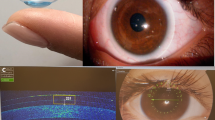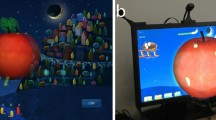Abstract
Parts of material previously presented at Annual Meetings of the Association for Research in Vision and Ophthalmology and the American Association of Pediatric Ophthalmology and Strabismus. Trial Registration: ClinicalTrials.gov Identifier: NCT00212134.
This is a preview of subscription content, access via your institution
Access options
Subscribe to this journal
Receive 18 print issues and online access
269,00 € per year
only 14,94 € per issue
Buy this article
- Purchase on SpringerLink
- Instant access to full article PDF
Prices may be subject to local taxes which are calculated during checkout

Similar content being viewed by others
Data availability
Additional Information Explanation for why data not available: Data are on children and PHI needs to be protected.
References
Hartmann EE, Stout AU, Lynn MJ, Yen KG, Kruger SJ, Lambert SR. Stereopsis results at 4.5 years of age in the infant aphakia treatment study. Am J Ophthalmol. 2015;159:64–70.e61-62.
Beck RW, Moke PS, Turpin AH, Ferris FL, SanGiovanni JP, Johnson CA, et al. A computerized method of visual acuity testing: adaptation of the early treatment of diabetic retinopathy study testing protocol. Am J Ophthalmol. 2003;135:194–205.
Lambert SR, Cotsonis G, DuBois L, Nizam A, Kruger S, Hartmann EE, et al. Long-term effect of intraocular lens vs contact lens correction on visual acuity after cataract surgery during infancy: a randomized clinical trial. JAMA Ophthalmol. 2020;138:365–72.
Giaschi D, Lo R, Narasimhan S, Lyons C, Wilcox LM. Sparing of coarse stereopsis in stereodeficient children with a history of amblyopia. J Vis. 2013;13:1–15.
Funding
This study was supported by the National Eye Institute of the National Institutes of Health, Department of Health and Human Services grants 1 R21 EY032152, 2 UG1 EY031287, 5 U10 EY013287, 5 UG1 EY02553, 7 UG1 EY013272, Research to Prevent Blindness. The funding organizations had no role in the design or conduct of this research.
Author information
Authors and Affiliations
Consortia
Contributions
Drs Hartmann, Drews-Botsch and Lambert had full access to all of the data in the study and took responsibility for the integrity of the data and the accuracy of the data analysis. Concept and design: Hartmann, DuBois, Drews-Botsch. Acquisition, analysis, or interpretation of data: All authors. Drafting of the manuscript: Hartmann, Drews-Botsch. Critical revision of the manuscript for important intellectual content: Hartmann, Lambert, Drews-Botsch. Statistical analysis: Hartmann, Drews-Botsch. Obtained funding: Lambert. Administrative, technical, or material support: Hartmann, Lambert, DuBois, Drews-Botsch. Supervision: Hartmann, Drews-Botsch.
Corresponding author
Ethics declarations
Competing interests
The authors declare no competing interests.
Additional information
Publisher’s note Springer Nature remains neutral with regard to jurisdictional claims in published maps and institutional affiliations.
Supplementary information
Rights and permissions
Springer Nature or its licensor (e.g. a society or other partner) holds exclusive rights to this article under a publishing agreement with the author(s) or other rightsholder(s); author self-archiving of the accepted manuscript version of this article is solely governed by the terms of such publishing agreement and applicable law.
About this article
Cite this article
Hartmann, E.E., Drews-Botsch, C., DuBois, L. et al. Stereopsis in the Infant Aphakia Treatment Study: outcome at 10½ years. Eye 39, 1426–1427 (2025). https://doi.org/10.1038/s41433-025-03731-3
Received:
Revised:
Accepted:
Published:
Issue Date:
DOI: https://doi.org/10.1038/s41433-025-03731-3



